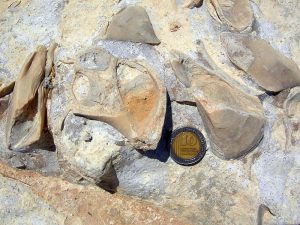Welcome! There is such wonderful paleontological material on the Web. Come here often! I’ll assume from the start that you all know the Geologic Time Scale, which will be critical to all that we do in this course. Here is our version of the Geological Time Scale. (Here is the latest professional version of the time chart. You don’t need to know all these names!) You will be referring throughout the semester to our course’s “Systematics” pages, sometimes called “the yellow book,” for the print-out you’ll receive in class. It is the same as this online pdf version.
Here are a few general links to paleontological resources to get us started. I will be using the University of California Museum of Paleontology (Berkeley) site often because it is very, very good. Here is their page on “learning from the fossil record“, with numerous educational and professional articles and links. The Paleontological Research Institution has an excellent site with introductory material (including “mystery fossils” to identify). It is oriented towards professionals and graduate students, but you can certainly have a go at it. Who knows — maybe a research paper topic is lurking in there? And I can’t let you go without links to my favorite organizations: The Paleontological Society and The Palaeontological Association. You certainly want to look at the projects of Wooster paleontologists over the past few years. You may also want to visit The Paleontology Portal which is “a central entryway to paleontology on the Web”. It is an excellent link to thousands of paleontological resources. (Check out their fossil gallery, which is organized by period.)
Virtual museums are the latest web rage. The Virtual Fossil Museum is one of the first of its kind. Eclectic, and I’m not sure who operates it, but it has many excellent photographs.
As far as this week’s material goes, the Web is often more misleading than helpful on the topic of fossil preservation. Many common terms (like mold and cast) are misused. The Wikipedia section on fossil preservation may be our best start.
The new Time Scavengers blog is an excellent resource for geology students, especially those interested in paleontology. University of Tennessee graduate students Jen Bauer and Adriane Lam have put together a fantastic collection of articles, teaching aids, and links just for students like you!
Our theme song!

Jurassic fossils in southern Israel (Matmor Formation, Makhtesh Gadol, near Dimona). Click for larger view.
Geology in the News —
Viruses, phytoplankton and clouds. How would have guessed they are connected? A common type of oceanic phytoplankton (coccolithophores) covers itself with tiny mineralized (calcite) plates. Some get infected by a virus, which causes them to shed the plates. Waves throw the plates into the atmosphere, where they provide the seeds for clouds. One theme of this course is that life and the physical Earth are complexly intertwined. Life is a geological process.
Our big toes were the last parts of our feet to evolve. A related question is always what’s up with our littlest toes. Are we losing them?
Here’s a podcast on taxonomic vandalism. Never thought I’d put those two words together. It is a growing problem.
